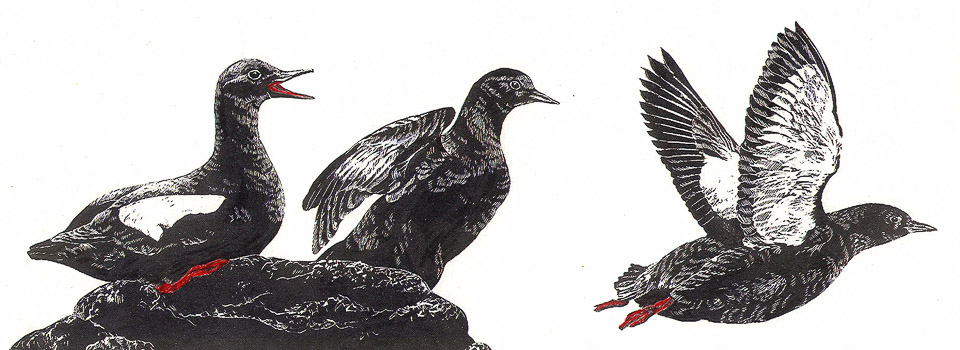| CLOUD RIDGE STAFF & GUEST LEADERS
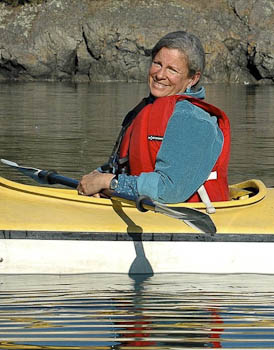 Audrey Benedict is the Founder and Director
of Cloud Ridge Naturalists and the Publisher of
Cloud Ridge Publishing. Her passion for geology
and biology inspired a 45-year love affair with
high mountains and the global ocean realm that
has taken her from the Arctic to the Antarctic, as
well as up and down the North and South American
Cordillera. Audrey is the author of several
books, including The Naturalist’s Guide to the
Southern Rockies: Southern Wyoming, Colorado,
and Northern New Mexico and Valley of the
Dunes: Great Sand Dunes National Park and
Preserve, the latter a collaborative effort with
photographers Bob Rozinski and Wendy Shattil.
Her most recent book, with coauthor Joe Gaydos,
is The Salish Sea: Jewel of the Pacific Northwest,
a visually stunning and important conservation
book designed, produced, and financially
supported by Cloud Ridge’s publishing team.
Audrey serves on the Board of Directors for the
SeaDoc Society. She divides her time between her
Colorado mountain home near the Indian Peaks
Wilderness Area and her tiny off-grid retreat on
Frost Island in Washington’s San Juan Islands. Audrey Benedict is the Founder and Director
of Cloud Ridge Naturalists and the Publisher of
Cloud Ridge Publishing. Her passion for geology
and biology inspired a 45-year love affair with
high mountains and the global ocean realm that
has taken her from the Arctic to the Antarctic, as
well as up and down the North and South American
Cordillera. Audrey is the author of several
books, including The Naturalist’s Guide to the
Southern Rockies: Southern Wyoming, Colorado,
and Northern New Mexico and Valley of the
Dunes: Great Sand Dunes National Park and
Preserve, the latter a collaborative effort with
photographers Bob Rozinski and Wendy Shattil.
Her most recent book, with coauthor Joe Gaydos,
is The Salish Sea: Jewel of the Pacific Northwest,
a visually stunning and important conservation
book designed, produced, and financially
supported by Cloud Ridge’s publishing team.
Audrey serves on the Board of Directors for the
SeaDoc Society. She divides her time between her
Colorado mountain home near the Indian Peaks
Wilderness Area and her tiny off-grid retreat on
Frost Island in Washington’s San Juan Islands.
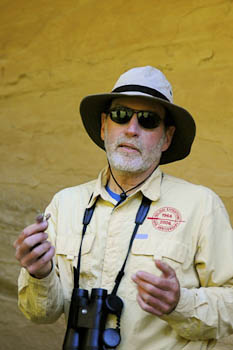 Dr. Geoff Hammerson Dr. Geoff Hammerson is Senior Research
Zoologist for NatureServe and lives in Port
Townsend, Washington. Geoff is the lead biologist
on Cloud Ridge’s naturalist team, helping design
and guide our field discovery program around
the world. He is the author of the definitive field
guide Amphibians and Reptiles in Colorado, as
well as Connecticut Wildlife. This Pacific
Northwest “convert” is currently at work, with
co-author Audrey Benedict, on a book about the
Pacific Flyway. A superb zoologist, Geoff is
always adding new dimensions to his natural
history expertise. He’s a popular instructor
wherever he goes, teaching field biology and
ecology at Wesleyan University and other
institutions. Geoff is perhaps best known as an
extraordinary observer of the natural world and
for his remarkable talent in sharing these field
experiences with audiences of all ages. Dr. Geoff Hammerson Dr. Geoff Hammerson is Senior Research
Zoologist for NatureServe and lives in Port
Townsend, Washington. Geoff is the lead biologist
on Cloud Ridge’s naturalist team, helping design
and guide our field discovery program around
the world. He is the author of the definitive field
guide Amphibians and Reptiles in Colorado, as
well as Connecticut Wildlife. This Pacific
Northwest “convert” is currently at work, with
co-author Audrey Benedict, on a book about the
Pacific Flyway. A superb zoologist, Geoff is
always adding new dimensions to his natural
history expertise. He’s a popular instructor
wherever he goes, teaching field biology and
ecology at Wesleyan University and other
institutions. Geoff is perhaps best known as an
extraordinary observer of the natural world and
for his remarkable talent in sharing these field
experiences with audiences of all ages.
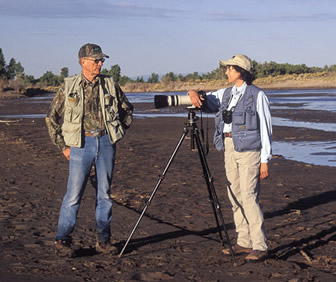 Bob Rozinski & Wendy Shattil are the rarest
of species—full-time professional nature
photographers. They’ve worked individually
and as a team for more than 30 years and are
known world-wide for their award-winning
images and reputations as environmental
photographers of endangered species and at-risk ecosystems throughout North America. Fellows
of the International League of Conservation
Photographers, Bob and Wendy have produced
twelve books, and their images have appeared in
National Wildlife, Audubon, Nature Conservancy,
BBC Wildlife, Nature’s Best, National Geographic publications, and many others. Wendy also serves
as the Project and Image Director for Cloud Ridge
Publishing and brings her expertise and critical
eye to everything we do. Dedicated to developing
new ways of illuminating key conservation issues,
Bob and Wendy are superb teachers and generous
in sharing their expertise. To see more of their
photographic work, visit their website: www.dancingpelican.com Bob Rozinski & Wendy Shattil are the rarest
of species—full-time professional nature
photographers. They’ve worked individually
and as a team for more than 30 years and are
known world-wide for their award-winning
images and reputations as environmental
photographers of endangered species and at-risk ecosystems throughout North America. Fellows
of the International League of Conservation
Photographers, Bob and Wendy have produced
twelve books, and their images have appeared in
National Wildlife, Audubon, Nature Conservancy,
BBC Wildlife, Nature’s Best, National Geographic publications, and many others. Wendy also serves
as the Project and Image Director for Cloud Ridge
Publishing and brings her expertise and critical
eye to everything we do. Dedicated to developing
new ways of illuminating key conservation issues,
Bob and Wendy are superb teachers and generous
in sharing their expertise. To see more of their
photographic work, visit their website: www.dancingpelican.com
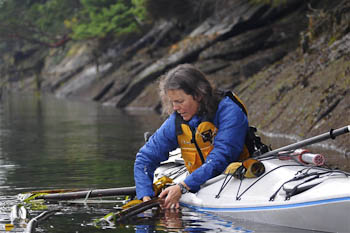 Jennifer Hahn, a naturalist, writer, illustrator,
teacher, wild harvester, and coastal traveler, has
over 30 years of wilderness travel experience.
She has guided natural history trips by sea kayak
in the San Juan Islands and Southeast Alaska for
22 years. She is the author of two books: the
award-winning Spirited Waters: Soloing South
Through the Inside Passage, based on her solo kayak
trip from Southeast Alaska to Washington,
and Pacific Feast: A Cook’s Guide to West Coast
Foraging and Cuisine. Jenny teaches courses in
wild foraging, indigenous plant uses, and seaweed
biology as an adjunct professor at Western
Washington University’s Fairhaven College and
other institutions. The expertise, poetic voice, and
infectious enthusiasm she brings to her natural
history teaching is a rare gift. Learn more about
Jenny’s work: www.pacificfeast.com Jennifer Hahn, a naturalist, writer, illustrator,
teacher, wild harvester, and coastal traveler, has
over 30 years of wilderness travel experience.
She has guided natural history trips by sea kayak
in the San Juan Islands and Southeast Alaska for
22 years. She is the author of two books: the
award-winning Spirited Waters: Soloing South
Through the Inside Passage, based on her solo kayak
trip from Southeast Alaska to Washington,
and Pacific Feast: A Cook’s Guide to West Coast
Foraging and Cuisine. Jenny teaches courses in
wild foraging, indigenous plant uses, and seaweed
biology as an adjunct professor at Western
Washington University’s Fairhaven College and
other institutions. The expertise, poetic voice, and
infectious enthusiasm she brings to her natural
history teaching is a rare gift. Learn more about
Jenny’s work: www.pacificfeast.com
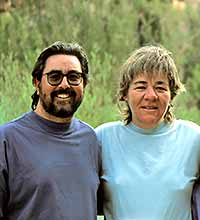 Carol and Carlos Passera are naturalists and
conservationists in the grand tradition. Their
knowledge of Patagonia’s natural and cultural
heritage is unsurpassed. They live in Puerto
Madryn, on Patagonia’s Atlantic coast, and their
world-renowned ecotourism company, Causana
Viajes, creates and guides extraordinary natural
history trips throughout Argentinian and Chilean
Patagonia as well as in the Antarctic and
Subantarctic. Carol Mackie is of Welsh/Scottish
descent, her great great grandmother having
been among the first Welsh immigrants to settle
in Patagonia’s Chubut Valley in the 1880s. The
breadth of Carol’s expertise makes her an
inspiring tour leader. Her passion for all things
“Patagonian” is absolutely contagious! Carlos
Passera is a conservation journalist, a nature
photographer, an Antarctic expedition guide and
lecturer, and is the author of 3 books. Born and educated in Buenos Aires, where he met and
married Carol, Carlos fell in love with Patagonia
in 1979. The focus of their professional lives
changed forever when he accepted the Head
Ranger position at the Punta Tombo penguin
colony. Raising 3 young children and living
remotely among several thousand Magellanic
penguins is not for the faint hearted! Over the past
20 years, Carlos and Carol have worked tirelessly
at the forefront of conservation efforts in
Patagonia and well beyond. Carol and Carlos Passera are naturalists and
conservationists in the grand tradition. Their
knowledge of Patagonia’s natural and cultural
heritage is unsurpassed. They live in Puerto
Madryn, on Patagonia’s Atlantic coast, and their
world-renowned ecotourism company, Causana
Viajes, creates and guides extraordinary natural
history trips throughout Argentinian and Chilean
Patagonia as well as in the Antarctic and
Subantarctic. Carol Mackie is of Welsh/Scottish
descent, her great great grandmother having
been among the first Welsh immigrants to settle
in Patagonia’s Chubut Valley in the 1880s. The
breadth of Carol’s expertise makes her an
inspiring tour leader. Her passion for all things
“Patagonian” is absolutely contagious! Carlos
Passera is a conservation journalist, a nature
photographer, an Antarctic expedition guide and
lecturer, and is the author of 3 books. Born and educated in Buenos Aires, where he met and
married Carol, Carlos fell in love with Patagonia
in 1979. The focus of their professional lives
changed forever when he accepted the Head
Ranger position at the Punta Tombo penguin
colony. Raising 3 young children and living
remotely among several thousand Magellanic
penguins is not for the faint hearted! Over the past
20 years, Carlos and Carol have worked tirelessly
at the forefront of conservation efforts in
Patagonia and well beyond.
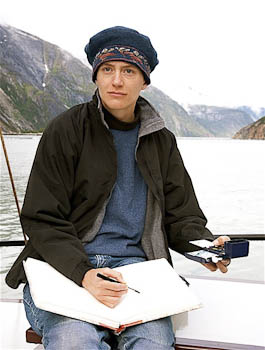 Sarah Drummond is a naturalist and artist who
grew up traveling with Cloud Ridge and is now a
member of our naturalist team. Her B.A. from
Maine’s College of the Atlantic emphasized
ecology, island ecosystems and art. Sarah’s M.A.
from Arizona’s Prescott College focused on the
role and impact of artists accompanying major
exploring expeditions and was based on research
gathered during a Watson Foundation year abroad.
She works as a naturalist/kayak guide for Pacific
Catalyst. Her illustrations are featured in several
books and a recent book of block prints, Raven
and the Red Ball, is a Pomegranate Books best
seller. Sarah’s artwork celebrates the beauty and
diversity of the natural world. Visit her website: www.sarahdrummondart.com Sarah Drummond is a naturalist and artist who
grew up traveling with Cloud Ridge and is now a
member of our naturalist team. Her B.A. from
Maine’s College of the Atlantic emphasized
ecology, island ecosystems and art. Sarah’s M.A.
from Arizona’s Prescott College focused on the
role and impact of artists accompanying major
exploring expeditions and was based on research
gathered during a Watson Foundation year abroad.
She works as a naturalist/kayak guide for Pacific
Catalyst. Her illustrations are featured in several
books and a recent book of block prints, Raven
and the Red Ball, is a Pomegranate Books best
seller. Sarah’s artwork celebrates the beauty and
diversity of the natural world. Visit her website: www.sarahdrummondart.com
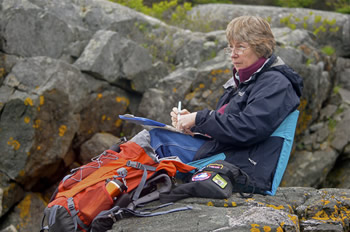
Marilyn Hailbronner’s drawings—rendered in pen and ink, scratchboard technique, and color wash—grace Cloud Ridge’s brochure and website. Her work as a naturalist artist is a reflection of her love for the natural world and her passion for conservation has taken her to wilderness areas around the world. To see Marilyn’s artwork: www.wildinkwell.com
GUEST LECTURERS
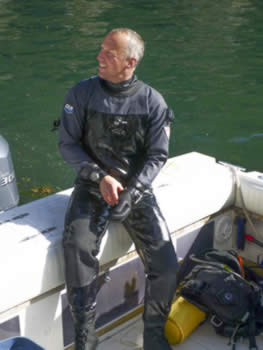 Dr. Joe Gaydos lives on Orcas Island with his
family and is a wildlife veterinarian and Chief
Scientist for the SeaDoc Society, a nonprofit
science-based marine conservation program of the
UC Davis Veterinary Medicine/Wildlife Health
Center. Joe has focused SeaDoc’s research efforts
on the ecosystem-level challenges facing the
Salish Sea and has worked to improve management
and policy decisions regarding the stewardship
of those resources. He’s coauthor, with
Audrey Benedict, of The Salish Sea: Jewel of the
Pacific Northwest and the two are currently at
work on a children’s version. Joe has published
extensively on marine wildlife health issues for such species as harbor seals, river otters, and
killer whales. His passion for connecting people
to the magic and vulnerability of the marine world
is legendary! Dr. Joe Gaydos lives on Orcas Island with his
family and is a wildlife veterinarian and Chief
Scientist for the SeaDoc Society, a nonprofit
science-based marine conservation program of the
UC Davis Veterinary Medicine/Wildlife Health
Center. Joe has focused SeaDoc’s research efforts
on the ecosystem-level challenges facing the
Salish Sea and has worked to improve management
and policy decisions regarding the stewardship
of those resources. He’s coauthor, with
Audrey Benedict, of The Salish Sea: Jewel of the
Pacific Northwest and the two are currently at
work on a children’s version. Joe has published
extensively on marine wildlife health issues for such species as harbor seals, river otters, and
killer whales. His passion for connecting people
to the magic and vulnerability of the marine world
is legendary!
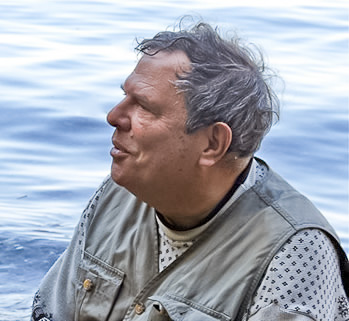 Russel Barsh spent his Long Island boyhood on
as a devoted beachcomber and fossil-hunter. As a
doctoral student in paleontology at Harvard, he
was mentored in multidisciplinary studies by the
late Loren Eiseley and Stephen Jay Gould. His
friendships with Native Americans opened his
eyes to new science challenges, convincing him
to get a law degree and defend the environmental
integrity of traditional cultures. Russel taught at
the University of Washington and helped develop
its American Indian Studies Center. He served
as an advisor to United Nations agencies on
indigenous and peoples living in sensitive ecosystems,
establishing the UN’s Forum on Indigenous
Issues. Russel co-founded Kwiáht (Center for the
Historical Ecology of the Salish Sea) at the urging
of his longtime friend and Samish Tribal leader,
the late Ken Hanson. Kwiáht means “a clean
place” in the Native American language of the
Central Sound—a one-word mission statement
embracing the use of science to inform and
promote stewardship of cultural and biological
resources in the San Juan Archipelago. Russel Barsh spent his Long Island boyhood on
as a devoted beachcomber and fossil-hunter. As a
doctoral student in paleontology at Harvard, he
was mentored in multidisciplinary studies by the
late Loren Eiseley and Stephen Jay Gould. His
friendships with Native Americans opened his
eyes to new science challenges, convincing him
to get a law degree and defend the environmental
integrity of traditional cultures. Russel taught at
the University of Washington and helped develop
its American Indian Studies Center. He served
as an advisor to United Nations agencies on
indigenous and peoples living in sensitive ecosystems,
establishing the UN’s Forum on Indigenous
Issues. Russel co-founded Kwiáht (Center for the
Historical Ecology of the Salish Sea) at the urging
of his longtime friend and Samish Tribal leader,
the late Ken Hanson. Kwiáht means “a clean
place” in the Native American language of the
Central Sound—a one-word mission statement
embracing the use of science to inform and
promote stewardship of cultural and biological
resources in the San Juan Archipelago.
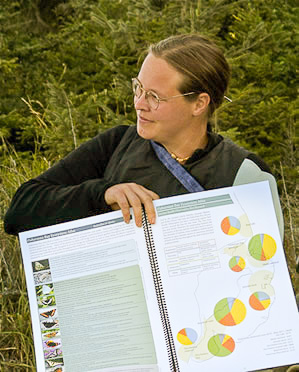 Madrona Murphy is a native Lopezian, whose
love for the San Juan Islands eventually brought
her back to Lopez Island after earning a degree
in botany and political science at Reed College.
With a special interest in plant genetics, she
worked as a technician at the University of
Washington’s Center for Cell Dynamics at Friday
Harbor Laboratories before establishing and
managing Kwiáht’s genotyping laboratory.
Madrona uses her knowledge of how indigenous
peoples used the land and shaped the ecosystems
that we see today to inform her botanical surveys
and her design of restoration projects. Her genetic
population studies include work on local salmon,
coastal cutthroat trout, camas, small mammals,
and the rare Island Marble butterfly. Madrona Murphy is a native Lopezian, whose
love for the San Juan Islands eventually brought
her back to Lopez Island after earning a degree
in botany and political science at Reed College.
With a special interest in plant genetics, she
worked as a technician at the University of
Washington’s Center for Cell Dynamics at Friday
Harbor Laboratories before establishing and
managing Kwiáht’s genotyping laboratory.
Madrona uses her knowledge of how indigenous
peoples used the land and shaped the ecosystems
that we see today to inform her botanical surveys
and her design of restoration projects. Her genetic
population studies include work on local salmon,
coastal cutthroat trout, camas, small mammals,
and the rare Island Marble butterfly.
|
